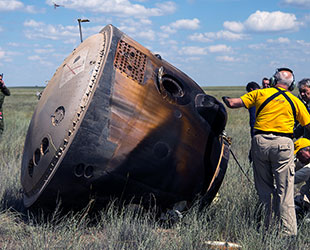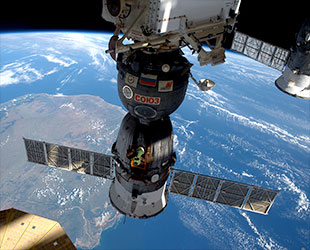Dec. 6, 2016 — The spacecraft that returned Britain's first professional astronaut to Earth in June will land on display in London next year.
Russia's Soyuz TMA-19M descent module, which touched down from the International Space Station with Expedition 46/47 flight engineer Tim Peake with the European Space Agency (ESA), will go on exhibit at the Science Museum, London in early 2017.
"You do become very attached to your spacecraft because it definitely does save your life," said Peake in a statement released by the Science Museum Group on Monday (Dec. 5). "I'm absolutely delighted that my Soyuz spacecraft, the TMA-19M, is going to be returning here to the UK and may serve, hopefully, as [an] inspiration for our next generation of scientists and engineers."
The 1.7 ton (1.5 metric ton) capsule, which flew Peake and his two crewmates, Russian cosmonaut Yuri Malenchenko and U.S. astronaut Tim Kopra, to and from the station, was acquired by the Science Museum Group (SMG), which is responsible for several UK cultural institutions.

Russia's Soyuz TMA-19M spacecraft in Kazakhstan after its return from 185 days at the International Space Station. (NASA/Bill Ingalls) |
"Russian ingenuity led to the birth of the space age," said Ian Blatchford, SMG's director. "Today it still plays a critical role, notably in long duration missions to pave the way for the next great leap into the cosmos."
"It is a great honor to be here to officially acquire the first flown human spacecraft in the [SMG] collection, one which allowed Tim Peake to make his historic journey," he stated.
Blatchford's signing of the acquisition agreement for Soyuz TMA-19M coincided with the 50th anniversary of the first Soyuz launch in 1966.
The display of the Soyuz TMA-19M descent module builds on the Science Museum's recent exhibition, "Cosmonauts: Birth of the Space Age," which brought in 140,000 visitors, making it the museum's most popular exhibit in its history. "Cosmonauts" included the display of Soyuz TM-14, which flew the first mission to Russia's Mir space station after the fall of the Soviet Union in 1992.
The exhibition, which ran from September 2015 to March 2016, also included the construction and display of a two-thirds scale replica of a Soyuz orbital module built entirely from a quarter of a million LEGO bricks.
SMG acquired the Soyuz TM-19M from RSC Energia, the Russian contractor responsible for building the Soyuz and a partner in the "Cosmonauts" exhibition.

Russia's Soyuz TMA-19M seen docked to the International Space Station. Only the middle, descent module returns to Earth. (NASA) |
"We're very honored that a descent vehicle produced by our corporation will take its rightful place in the collection of one of the most important science museum groups in the world," said Vladimir Soltnsev, general director of Energia. "I would like to hope that this special symbol of Russia will become one of the highlights of the Science Museum."
Soyuz TMA-19M is the latest Russian spacecraft to land on display in the home country of one of its crew.
In September, the Soyuz TMA-03M descent module, which landed with Dutch ESA astronaut André Kuipers from the International Space Station in 2012, debuted on display at Space Expo in Noordwijk, The Netherlands. Similarly, the Soyuz capsules that returned U.S. space flight participants Charles Simonyi and Greg Olsen to Earth are exhibited in Seattle and New York City, respectively.
Other astronauts' Soyuz capsules are on display in Cuba, the Czech Republic, Bulgaria, France, Germany, Hungary, India, Poland, Romania and Vietnam.
Soyuz TMA-19M will not be the only flown spacecraft on exhibit at the Science Museum, London when it premieres next year. The museum also has on display NASA's Apollo 10 command module, which flew to the moon in May 1969 on a full-up dress rehearsal for the first lunar landing. The capsule, named "Charlie Brown," is on long-term loan from the Smithsonian Institution in Washington, DC.
